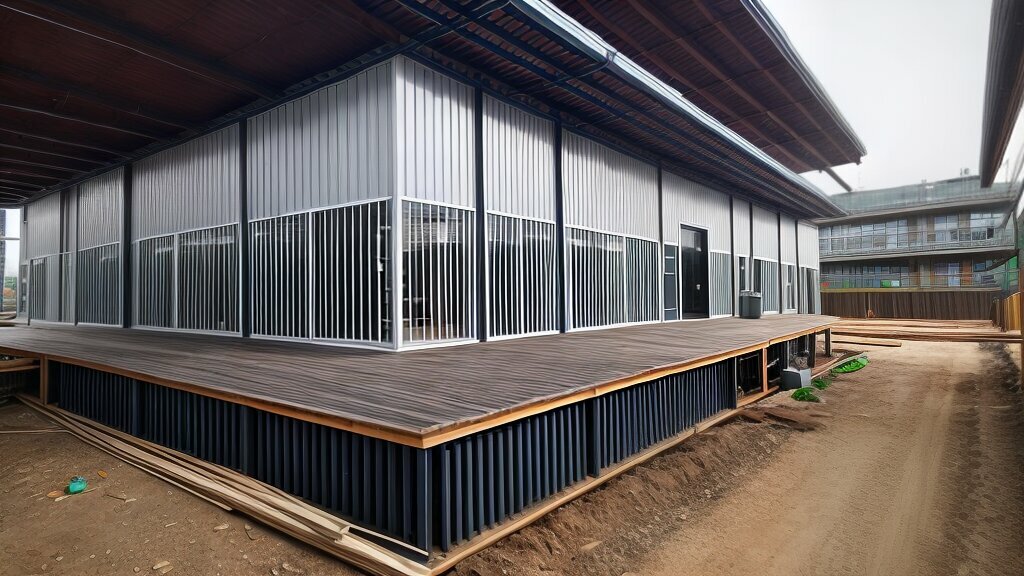Responsible Wood Sourcing in Construction: Balancing Demand and Conservation
Welcome to our article on responsible wood sourcing in construction. As the demand for timber continues to grow, it is becoming increasingly important to balance this demand with conservation efforts. In this article, we will discuss the significance of sustainable timber and ethical construction practices that prioritize environmentally friendly building materials. We will explore the role of wood certification in ensuring responsible sourcing and highlight the benefits of sustainable forestry. Let’s dive right in to learn more about how we can promote responsible wood sourcing in the construction industry.
Key Takeaways:
- The demand for timber in construction must be balanced with conservation efforts.
- Sustainable timber and ethical construction practices prioritize environmentally friendly materials.
- Wood certification is vital to ensuring responsible sourcing.
- Collaborative efforts are crucial to achieving sustainable construction practices.
Understanding Sustainable Timber
As the demand for wood in the construction industry grows, it’s becoming increasingly important to ensure that the timber used is sustainably sourced. Sustainable timber is wood that has been harvested in a way that minimizes its impact on the environment while still meeting the needs of the present and future generations. This means that responsible sourcing guidelines must be followed to ensure that the forest ecosystems are protected and the forestry industry is sustainable.
One of the main benefits of using sustainable timber in construction is that it contributes to eco-friendly building practices. Sustainable timber is often used in conjunction with other environmentally friendly building materials, such as recycled steel and concrete, to create sustainable building designs. Using sustainable timber also ensures that the construction project is aligned with ethical construction practices that prioritize the use of environmentally sound materials.

It’s important to note that not all wood is created equal. Some types of wood are more sustainable than others, depending on factors such as the growth rate, the region of origin, and the forest management practices. For example, using tropical hardwoods that have been illegally harvested from rainforests contributes to deforestation and threatens the biodiversity of the region. On the other hand, using locally grown softwoods from sustainably managed forests supports the local economy and ensures that the forest is replenished with new trees.
Understanding Sustainable Timber Certification
One way to ensure that the timber used in construction is sustainably sourced is through wood certification schemes. Wood certification is a way to verify that the wood has been harvested in a sustainable manner and meets responsible sourcing guidelines. The two most widely recognized certification schemes are the Forest Stewardship Council (FSC) and the Programme for the Endorsement of Forest Certification (PEFC).
When choosing sustainable timber for a construction project, it’s important to look for wood that has been certified by a reputable certification scheme. These certifications provide assurance that the wood has been harvested in line with responsible sourcing guidelines, ensuring that the construction project is aligned with eco-friendly and ethical practices.
The Value of Wood Certification
In the pursuit of responsible wood sourcing in construction, wood certification plays a crucial role in ensuring the timber is ethically sourced and environmentally friendly. Wood certification schemes provide a means of verifying that wood and wood products originate from responsibly managed forests. By adhering to responsible sourcing guidelines and obtaining wood certification, construction companies can ensure their timber products are sustainably sourced and contribute to the overall sustainability of their projects.
The Forest Stewardship Council (FSC) and Programme for the Endorsement of Forest Certification (PEFC) are two of the most recognized certification schemes in the construction industry. FSC certification ensures that forests are responsibly managed, and the timber products are produced with respect for the highest ecological, social and ethical standards. PEFC certification provides assurance that forests are managed according to strict environmental, social and economic standards.
Certification schemes such as FSC and PEFC provide a clear and objective standard for responsible forestry practices. They also ensure that timber producers and buyers can trace their wood products to sustainably managed forests. This traceability is essential to determining the origin of the wood, its legality, and the impact that its production has had on the environment.

In addition to contributing to the sustainability of construction projects, obtaining wood certification can also positively affect a company’s reputation and client satisfaction. Clients are becoming increasingly aware of the importance of responsible sourcing and ethical practices, and are more likely to choose construction companies that demonstrate a commitment to sustainability.
In conclusion, wood certification is a powerful tool in promoting responsible wood sourcing in construction. By obtaining certification from reputable schemes such as FSC and PEFC, construction companies can ensure their timber products are ethically sourced and environmentally friendly, contributing to the overall sustainability of their projects. Wood certification can also positively impact a company’s reputation and client satisfaction, further emphasizing the importance of its role in responsible wood sourcing.
Challenges in Responsible Wood Sourcing
Despite the benefits of responsible wood sourcing, the construction industry faces several challenges in achieving this goal. Irresponsible sourcing practices can have a significant environmental impact, including deforestation, soil erosion, and habitat destruction for wildlife. The demand for timber from developing countries can also lead to exploitation of local communities and illegal logging activities.
Sustainable forestry is crucial to promoting responsible wood sourcing. It involves managing forests in a way that meets the needs of the present generation without compromising the ability of future generations to meet their own needs. However, sustainable forestry can be costly and time-consuming, making it challenging for some companies to adopt these practices.
Another challenge is ensuring that responsible sourcing guidelines are followed throughout the supply chain. This process can be complex, with multiple stakeholders involved in the procurement, transportation, and processing of timber. It requires close collaboration between contractors, suppliers, and certification bodies to ensure that all parties are committed to responsible sourcing practices.
Despite these challenges, the construction industry must make a concerted effort to promote responsible wood sourcing. By working together to overcome these obstacles, the industry can reduce its environmental impact and ensure the availability of sustainable timber for future generations.

Image source: https://seowriting.ai/32_6.png
Benefits of Responsible Wood Sourcing
The use of responsible wood sourcing practices in construction offers numerous benefits, both for the environment and for stakeholders involved in building projects. By using sustainable construction materials, builders can significantly reduce the environmental footprint of their buildings, while also promoting ethical practices and improving their reputation. Here are some of the key benefits of responsible wood sourcing:
- Reduced environmental impact: By using wood that is responsibly sourced, the construction industry can significantly reduce its impact on the environment. Sustainable forestry practices ensure the long-term health of forests, protecting the habitats of wildlife and promoting biodiversity.
- Positive reputation: Companies that prioritize responsible wood sourcing and other sustainable practices can establish themselves as environmental leaders in their industry. This can enhance the company’s reputation and attract environmentally conscious clients and partners.
- Client satisfaction: Clients increasingly expect construction companies to prioritize sustainability and ethical practices. By using responsibly sourced wood, builders can satisfy these expectations and enhance client satisfaction.
- Long-term sustainability: The use of sustainable materials, such as responsibly sourced wood, promotes long-term sustainability in the construction industry. This can help reduce waste and improve the overall environmental impact of the industry.
Responsible wood sourcing is an essential part of promoting sustainable construction practices. By prioritizing ethical and environmentally friendly building materials, the construction industry can reduce its impact on the environment, enhance its reputation, and promote long-term sustainability.

Implementing Responsible Wood Sourcing
Implementing responsible wood sourcing practices is a crucial step towards achieving sustainability in the construction industry. There are several ways in which building professionals can incorporate responsible sourcing into their procurement processes.
Procurement processes: Contractors and builders should prioritise the use of sustainable wood products when sourcing materials for construction projects. This should involve conducting an assessment of the environmental impact of potential suppliers and selecting those that adhere to responsible sourcing guidelines. This evaluation should also involve taking into account the supplier’s certifications to ensure that their products meet the required standards.
Supply chain management: Building professionals should work with their suppliers to develop responsible supply chain management practices. This may involve providing training to suppliers on sustainable forestry practices, conducting regular audits to ensure compliance, and setting clear expectations for the procurement of wood products.
It is also important to ensure that suppliers of wood products provide documentation that outlines the chain of custody for the materials, from harvesting to delivery.
Project specifications: Project specifications should be reviewed to ensure that they align with responsible wood sourcing practices. This may involve specifying certain certifications for suppliers to adhere to or outlining the preferred sourcing region for wood products.
It is important to work with industry associations and certification bodies to stay up-to-date on responsible sourcing guidelines and best practices. This collaboration ensures that building professionals can continue to implement sustainable practices throughout the construction process and contribute to the overall sustainability of the industry.

Collaboration for Sustainable Construction
Achieving sustainable construction practices requires collaboration among stakeholders in the industry. Contractors, architects, suppliers, and certification bodies can work together to promote responsible wood sourcing and reduce the environmental impact of construction activities.
Industry partnerships are crucial to sharing knowledge, resources, and best practices. By working together, stakeholders can establish responsible sourcing guidelines, adopt sustainable practices, and promote ethical construction practices.
Successful examples of collaborative efforts in promoting responsible wood sourcing include the Partnership for Sustainable Forests in the UK, which brings together companies, NGOs, and government agencies to promote sustainable forestry and responsible wood sourcing.
Collaboration is key to achieving sustainable construction practices that balance the demand for timber with conservation efforts. By forming partnerships and sharing knowledge, stakeholders can drive positive change towards a more environmentally friendly construction industry.

Future Trends in Responsible Wood Sourcing
The construction industry is constantly evolving, and responsible wood sourcing is becoming an increasingly important aspect of sustainable construction practices. Advancements in technology are making it easier to ensure transparency and traceability in the wood supply chain.
One of the most promising trends is the use of digital tracking and blockchain technology. This enables stakeholders to track the origin of products, ensuring that they are responsibly sourced. This transparency can also be passed on to consumers, who can make informed decisions about the products they choose to use in their construction projects.
Another trend is the use of innovative sustainable materials such as cross-laminated timber (CLT). CLT is made from wood, and it offers a more sustainable alternative to traditional materials such as concrete and steel. It is lightweight, strong, and has a lower carbon footprint than other materials.
Alongside these developments, there is an ongoing effort to improve sustainability practices and mitigate the environmental impact of construction activities. This includes reducing waste, increasing recycling, and developing more energy-efficient buildings.
Overall, the future of responsible wood sourcing in the construction industry looks bright. As technology continues to advance and environmental awareness grows, we can expect to see a greater emphasis on sustainable practices and a more eco-friendly approach to building construction.

Building Awareness and Education
Education is a critical tool for promoting responsible wood sourcing and sustainable construction practices. By building awareness of the importance of environmental conservation and sustainability, the construction industry can drive positive change and reduce its environmental impact.
Industry associations and certification bodies play a vital role in promoting education and awareness. They offer training courses, workshops, and resources to help professionals in the construction industry understand the importance of responsible sourcing guidelines, sustainable forestry, and eco-friendly construction materials. Educational institutions can also play a role in promoting sustainability education by developing relevant courses and programs to train future generations of construction professionals.
Continuous learning and knowledge exchange are essential to promote sustainable construction practices. Industry stakeholders must remain up-to-date with the latest developments in sustainable materials, technologies, and best practices to ensure that their projects align with responsible sourcing guidelines and environmental conservation efforts.
“Sustainability is no longer an option; it’s a necessity. Education is key to driving positive change and building a more sustainable future for the construction industry.”
Image source: 
Conclusion
In conclusion, responsible wood sourcing is essential in balancing the demand for timber with conservation efforts in the construction industry. As demonstrated throughout this article, adhering to sustainable practices and guidelines ensures that wood is procured in an ethical and environmentally friendly manner.
The value of wood certification cannot be overstated, with schemes such as the Forest Stewardship Council and Programme for the Endorsement of Forest Certification providing assurance of responsible sourcing. However, challenges still exist, and industry-wide collaboration is needed to overcome them and promote responsible wood sourcing.
The benefits of responsible wood sourcing are manifold, including the use of sustainable construction materials, reputational gain, client satisfaction, and long-term sustainability. Implementing responsible sourcing practices requires organizations to incorporate sustainable procurement processes and supply chain management into their projects.
Collaborative efforts between contractors, architects, suppliers, and certification bodies are crucial in promoting sustainable construction practices, ensuring transparency in the wood supply chain, and mitigating the environmental impact of construction activities.
Future trends in responsible wood sourcing aim to improve transparency and traceability using technological advancements such as digital tracking and blockchain. Underpinning all these efforts is the importance of building awareness and education around responsible wood sourcing, environmental conservation, and sustainable construction practices.
Overall, the construction industry’s commitment to responsible wood sourcing is essential for conservation efforts, and it is vital for us to continue driving positive change to ensure long-term sustainability.
FAQ
Q: What is responsible wood sourcing in construction?
A: Responsible wood sourcing in construction refers to the practice of procuring timber from sustainable forestry sources and adhering to responsible sourcing guidelines. It involves prioritizing environmentally friendly building materials and ethical construction practices to balance the demand for timber with conservation efforts.
Q: Why is sustainable timber important?
A: Sustainable timber is important because it contributes to responsible wood sourcing in construction. It ensures that the procurement of timber follows guidelines that prioritize environmental conservation and sustainable practices, making it an eco-friendly construction material choice.
Q: What is the value of wood certification?
A: Wood certification is valuable as it ensures responsible wood sourcing in construction. Certification schemes such as the Forest Stewardship Council (FSC) and Programme for the Endorsement of Forest Certification (PEFC) verify that timber has been sourced from sustainable forestry. Adhering to wood certification standards contributes to overall sustainability in construction projects.
Q: What are the challenges in responsible wood sourcing?
A: Responsible wood sourcing faces challenges such as potential environmental impact from irresponsible sourcing practices and the need for sustainable forestry. Overcoming these challenges requires industry-wide collaboration and the promotion of responsible wood sourcing practices.
Q: What are the benefits of responsible wood sourcing?
A: Responsible wood sourcing in construction offers several benefits. It reduces the environmental footprint of buildings by using sustainable construction materials. Ethical practices improve reputation, client satisfaction, and long-term sustainability.
Q: How can responsible wood sourcing be implemented in the construction industry?
A: Implementing responsible wood sourcing involves incorporating sustainable practices into procurement processes, supply chain management, and project specifications. Industry associations and certifications play a crucial role in promoting responsible sourcing.
Q: Why is collaboration important for sustainable construction?
A: Collaboration among stakeholders in the construction industry is vital to achieve sustainable construction practices. Partnerships between contractors, architects, suppliers, and certification bodies can drive responsible wood sourcing and promote sustainability.
Q: What are the future trends in responsible wood sourcing?
A: Future trends in responsible wood sourcing include advancements in technology, such as digital tracking and blockchain, to ensure transparency and traceability. Ongoing efforts are being made to improve sustainability practices and mitigate the environmental impact of construction activities.
Q: How can we build awareness and education around responsible wood sourcing?
A: Building awareness and education about responsible wood sourcing and sustainable construction practices involves the involvement of industry associations, educational institutions, and certification bodies. Continuous learning and knowledge exchange are essential to drive positive change.
Q: What is the importance of balancing demand and conservation in responsible wood sourcing?
A: Balancing the demand for timber with conservation efforts is crucial in responsible wood sourcing. It ensures the preservation of forests and biodiversity while meeting the construction industry’s needs. Sustainable practices, wood certification, and collaboration play key roles in achieving this balance.








